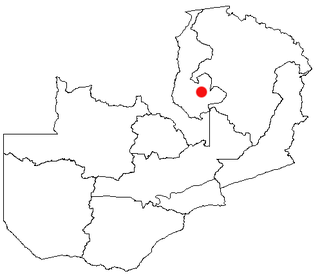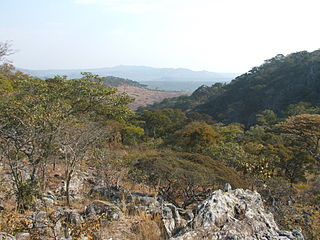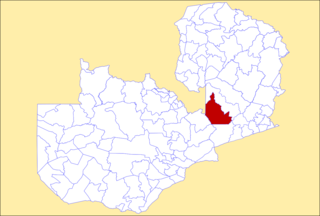 |
|---|
Serenje is a constituency of the National Assembly of Zambia. It covers Chisenga, Mapepela, Serenje and Wingie in Serenje District of Central Province. [1]
 |
|---|
Serenje is a constituency of the National Assembly of Zambia. It covers Chisenga, Mapepela, Serenje and Wingie in Serenje District of Central Province. [1]

The music of Zambia has a rich heritage which falls roughly into categories of traditional, popular and Christian music.
Nchelenge is a town in the Luapula Province of northern Zambia, lying on the south eastern shore of Lake Mweru. It is contiguous with Kashikishi, and they are sometimes referred to as Nchelenge-Kashikishi. Nchelenge is the administrative centre for the Zambian part of Lake Mweru, being the seat of the district government and branches of national agencies, while Kashikishi is the market and fisheries centre.

The Great North Road is a major route in Zambia, running north from Lusaka through Kabwe, Kapiri Mposhi, Serenje, Mpika, Isoka and Nakonde to the border with Tanzania. The entire route is designated as the T2 road on Zambia's road network. It forms the Zambian section of the Tanzam Highway.

Serenje is a town in Serenje District, Central Province, Zambia, lying just off the Great North Road and TAZARA Railway. Serenje has a railway station on the TAZARA railway. Serenje is approximately 191 km from Kapiri Mposhi on the Great North Road. Mkushi is the district west of Serenje. The Mulembo Falls lie near the town.

Samfya is a town located in the Zambian province of Luapula. It is the centre of Samfya District. The town is located on the south-western shore of Lake Bangweulu, on the longest stretch of well-defined shore of that lake. Samfya has a few guesthouses and a number of white sandy beaches which are used for recreation, although the lake does have crocodiles.

Central Province is one of Zambia's ten provinces. The provincial capital is Kabwe, which is the home of the Mulungushi Rock of Authority. Central Province has an area of 94,394 km (58,654 mi). It borders eight other provinces and has eleven districts. The total area of forest in the province is 9,095,566 ha, and it has a national park and three game management areas. The first mine in the region was opened up in 1905 making the then Broken Hill town the first mining town. In 1966, the town's name was reverted to its indigenous name - Kabwe meaning 'ore' or 'smelting'.
Kashikishi is a town on the south-eastern shore of Lake Mweru in the Luapula Province of Zambia. It lies just north of the district headquarters Nchelenge, and close enough for them to be considered twin towns; they are sometimes referred to as Nchelenge–Kashikishi.

Kabwe Central is a constituency of the National Assembly of Zambia. It covers part of Kabwe District in Central Province.

Chilubi District with headquarters at Chilubi is located in Northern Province, Zambia. It covers the north-east Lake Bangweulu and Bangweulu Wetlands containing several islands including Chilubi Island, and some of the mainland northeast of the lake. As of the 2000 Zambian Census, the district had a population of 66,338 people.
The Moto Moto Museum is a museum in Mbala, Zambia, housing a collection of artifacts related to Zambian culture, first collected by Canadian priest Jean Jacques Corbeil in the 1940s. The artifacts, collected for study and posterity by Father Cornbeil, were stored in the Mulilansolo Mission until 1964, when they were moved to Serenje, Zambia until 1969, then to Isoka. The current site, a former carpentry and bricklaying workshop, was donated by the Diocese of Mbala in 1972, to serve as a museum. When it opened in 1974, it was named the Moto Moto museum, after French Catholic Bishop Joseph Dupont, nicknamed Moto Moto, who began the White Fathers missionary in northern Zambia, where he worked from 1885 to 1911.

Railway stations in Zambia include:

Kundalila Falls, sometimes alternatively spelled as Nkundalila Falls, is an exquisite natural waterfall situated amidst the captivating escarpment landscape of Central Province, near the town of Kanona in the Serenje District. Cascading along the course of the Kaombe River, this waterfall descends from the formidable Muchinga Escarpment in a series of stages, collectively forming a mesmerizing drop of approximately 30 meters. The falls exhibit a distinctive morphology, initially resembling rivulets of rocky cascades at their zenith, converging into a double-barreled descent in their middle section, before ultimately coalescing into a single cascade as they reach their base. Kundalila Falls holds a prestigious status as a national heritage site under the purview of the National Heritage and Conservation Commission (NHCC). This designation was officially conferred upon the falls in the year 1964, underscoring its historical and ecological significance within Zambia.

Mkushi District is a district of Zambia, located in Central Province. The capital lies at Mkushi. As of the 2010 Zambian Census, the district had a population of 148,814 people. The Great North Road and TAZARA railway run through Mkushi district, connecting Kapiri Mposhi with Serenje, Mpika, Kasama & Tanzania. The area is largely undeveloped and home to numerous natural attractions including Lunsemfwa Wonder Gorge, Changwena Falls, and historic Fort Elwes.

Serenje District is a district of Zambia, located in Central Province. The capital lies at Serenje. As of the 2010 Zambian Census, the district had a population of 158,255 people. It consists of two constituencies, namely Serenje and Muchinga. The district contains Lake Lusiwasi.

Mambwe District is a district of Zambia, located in Eastern Province. Mambwe District inhabits the Luangwa Valley between the 13th and 14th parallel of south latitude. The Kunda name for this area is "Malambo''.

Muchinga is a constituency of the National Assembly of Zambia. It covers the towns of Chibale, Chisomo, Katota, Mukopa, Musoro, Nakosa and Sekeleti in Serenje District of Central Province.

Chitambo District is a district of Central Province, Zambia. It was separated from Serenje District in 2012 and is located some 357km north-east of Kabwe along the Great North Road. It shares borders with Serenje, Samfya, Lavushimanda and the Democratic Republic of Congo.
The M3 road is a road in northern Zambia that connects Kasama in the Northern Province with the Congo Pedicle border at Chembe in the Luapula Province via Luwingu and Mansa. The road contains two tollgates between Kasama and Mansa.
The Serenje Solar Power Station is a proposed 200 MW (270,000 hp) solar power plant in Zambia. The project is rated as the largest solar project in the country. The power station is under development by Ultra Green Corporation Zambia Limited, a subsidiary of Ultra Green Corporation Inc., an American independent power producer (IPP).